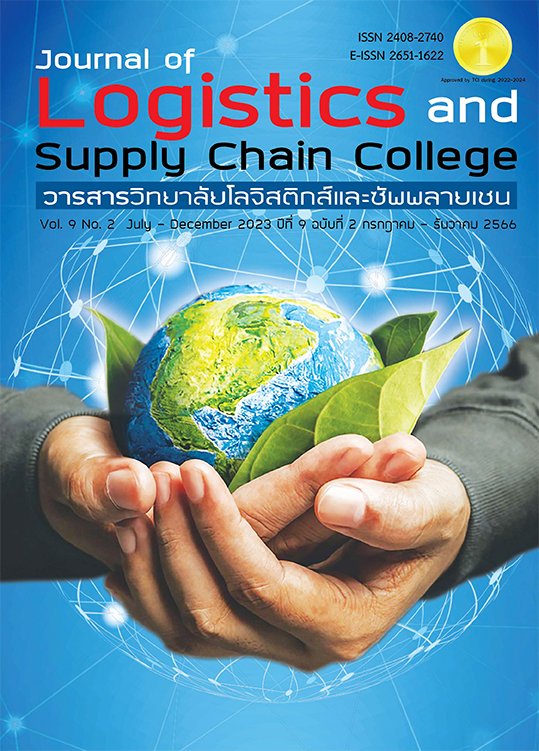Factors influencing hotel service quality in Hua Hin District
DOI:
https://doi.org/10.53848/jlscc.v9i2.263293Keywords:
Business factors, Hotel service quality, Hotels in Hua Hin DistrictAbstract
The objectives of this research were 1) to study the influence of business factors on the service quality of hotels in Hua Hin district; 2) to study the customer service behavior that influenced the service quality of hotels in Hua Hin District with quantitative research methodology
(Quantitative research). The population was those who visited 25 hotels in Hua Hin District using a simple random sampling method. The number of customers who use the service per day in 8 places was randomly drawn. The sample size was calculated using Taro Yamane’s formula, with 345 people. The statistics used were percentage, mean and standard deviation. The difference was analyzed by using statistics (analysis of variance ANOVA). The finding found that: 1) the age of most hotels is less than 10 years, representing 60.0 percent and the nature of management.
Self-managed business owner accounted for 57.68 percent. 2) Information on customer service behavior; the sample gives reasons for choosing to use the service with the hotel to travel to Hua Hin for the most visiting or visiting relatives in Hua Hin 43.47 percent took only 1 night to stay, representing 55.6 percent. The first reason was that they had stayed and liked it, which was the largest number, accounting for 35.6 percent. Secondly, to meet their specific needs.27.0%. Lastly, they received advice from friends or acquaintances. There are 22.9 percent the sample who had both been to and never stayed at that hotel. The number of people who have stayed at this hotel before is 55.39 percent. 3) The difference between business factors and service behavior affects the quality of service provided by the respondents. The reasons for choosing a hotel service the impact on customer service quality varies significantly at a .05 level. It does not affect the difference in the assessment of the quality of the five services statistically significantly at the .05 level in other words, the customer’s opinion of the quality of service. It’s not up to ever staying that feedback from the guests should pay attention to detailed service quality in response to guests’ needs. Moreover, the staff should receive training and attention to maintain the surrounding premises so they look new and modern, which can create more facilities to customers thoroughly and quickly.
References
ขวัญชนก สุวรรณพงศ์. (2563). คุณภาพการบริการของโรงแรมในอำเภอเมือง จังหวัดภูเก็ตเพื่อรองรับนักท่องเที่ยวกลุ่มความสนใจพิเศษ. วารสารมนุษยศาสตร์และสังคมศาสตร์ มหาวิทยาลัยราชพฤกษ์, 6(2), 1-2.
ชูชัย สมิทธิ์ไกร. (2561). พฤติกรรมผู้บริโภค. กรุงเทพฯ: จุฬาลงกรณ์มหาวิทยาลัย.
นพดล ชูเศษ, วิวัฒน์ จันทร์กิ่งทอง, กอแก้ว จันทร์กิ่งทอง และปัญจา ชูช่วย. (2561). องค์ประกอบคุณภาพการบริการของโรงแรมในอำเภอหาดใหญ่ จังหวัดสงขลา ที่มีอิทธิพลต่อความพึงพอใจของนักท่องเที่ยว. รายงานสืบเนื่องการประชุมหาดใหญ่วิชาการ ระดับชาติและนานาชาติครั้งที่ 9, วันที่ 20 กรกฎาคม 2561 ณ มหาวิทยาลัยหาดใหญ่ สงขลา.
ปรวีร์ คีรี. (2562). การรับรู้และความพึงพอใจในคุณภาพการบริการของผู้ใช้บริการโรงแรมราคาประหยัดในเขตสุขุมวิท กรุงเทพมหานคร.วิทยานิพนธ์ปริญญา บริหารธุรกิจ, มหาวิทยาลัยกรุงเทพ.
พชร เกษโกศล และจิตต์โสภิณ มีระเกตุ. (2561). อิทธิพลของคุณภาพบริการและความพึงพอใจของผู้ใช้บริการที่ส่งผลต่อความจงรักภักดีของผู้ใช้บริการโรงแรม และรีสอร์ทในเขตพื้นที่ตำบลหมูสี อำเภอปากช่อง จังหวัดนครราชสีมา. วารสารมนุษยศาสตร์และสังคมศาสตร์มหาวิทยาลัยราชพฤกษ์, 4(3), 1-2.
ศูนย์วิจัยกรุงศรี. (2564). สถานการณ์การท่องเที่ยวโลกและสถานการณ์การท่องเที่ยวของไทย. รายงานภาวะเศรษฐกิจการท่องเที่ยว ศูนย์วิจัยกรุงศรี, 1(4), 6-23.
สำนักงานการท่องเที่ยวและกีฬา ภาคตะวันตก. (2564). อนาคตของเทคโนโลยีในอุตสาหกรรมการท่องเที่ยว (ตอนที่ 1). วารสาร TAT Review Magazine 2564(4), 40.
อนิรุทธิ์ ผ่องแผ้ว. (2563). ปัจจัยที่มีผลต่อการตัดสินใจเข้าใช้บริการโรงแรมห้าดาวในกรุงเทพมหานคร.วารสารรัชต์ภาคย์, 2563(14), 36.
Cronbach, L.J. (1990). Essentials of psychological testing (5th ed.). New York: Harper Collins Publishers.
Herington, C. & Weaven, S. (2009). E-retailing by banks: e-service quality and its importance to customer satisfaction. European Journal of Marketing, 43(9/10).
Kotler, P. & Keller, K.L. (2012). Marketing management (14th ed.). New Jersey: Prentice Hall.
Parasuraman, A., Zeithaml, V.A. & Berry, L.L. (1994). A Conceptual Model of Service Quality and Its Implications for Future Research. Journal of Marketing, 7(3), 213-233.
Yamane, T. (1973). Elementary sampling theory.Englewood Cliffs, NJ: Prentice Hall.



